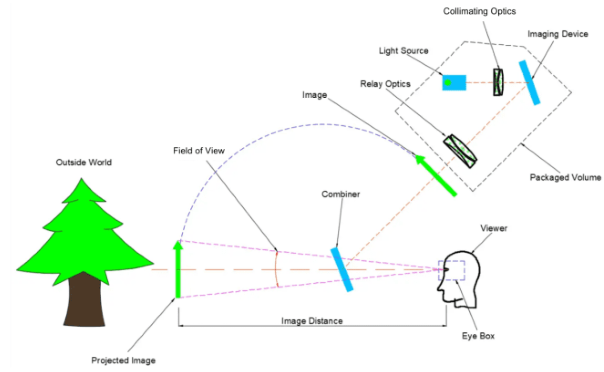The display presents virtual images to the user and is a key element of augmented reality (AR) and virtual reality (VR) devices. Optics play a vital part in providing a high-quality, comfortable-to-use display.
Generally, there are two types of displays in AR/VR devices: near-eye and projection. Near-eye displays are employed in devices such as VR headsets, where the display is positioned close to the user's eyes. Projection displays are used in devices such as AR smart glasses, where virtual images are projected onto a semi-transparent screen in front of the user's eyes.

Image Credit: Avantier Inc.
Both types of displays utilize optical components, including lenses, mirrors, and waveguides. These components control and direct the emitted light toward the user's eyes.
Lenses focus the light from near-eye displays onto the user's eyes, while mirrors and waveguides do the same in projection displays.

AR Schematic Diagram. Image Credit: Avantier Inc.
Enhancing Performance and Immersion
Another technique used to increase the performance of AR/VR displays is the application of optical coatings. For example, anti-reflection coatings improve image clarity and reduce glare when applied to lenses and other optical components.
AR and mixed reality (MR) employ transparent displays to overlay virtual content in the real world. This requires precise control over the direction and angle of the transmitted light, as well as the ability to adjust the focal length of the optical system to match the distance of the virtual objects. Additionally, it often involves using various optical elements, such as waveguides, to direct and shape the light in specific ways.
Conversely, VR employs opaque displays to completely immerse the user in a virtual environment. Optics are critical for VR because the display must create a realistic 3D image that appears at a fixed distance from the user, even as the user moves their head and eyes.
To achieve this, a high-resolution display is required, with a wide field of view and complex optical systems that adjust the focus and alignment of the image for each eye.
Current Challenges in AR/VR/MR Applications
Field of View
A wide field of view is required to create a convincing virtual overlay on the real world. However, creating a wide field of view often leads to optical aberrations and distortion, reducing the image quality and impacting user experience.
Display Resolution
VR requires high-resolution displays to create a realistic virtual environment; however, pixel size decreases as display resolution increases. As a result, maintaining high image quality while also controlling the amount of light reaching the user's eyes can be difficult.
Depth Perception
Creating a realistic 3D image also requires close control over the convergence and accommodation of the user's eyes. Current display technology makes this challenging and can result in visual discomfort and fatigue.
Size and Weight
Devices must be lightweight and compact to be practical for everyday use, limiting the optical system's complexity. This makes achieving high-quality images difficult without sacrificing portability and comfort.
Optics is essential for the high-quality displays necessary for immersive experiences. To schedule a free consultation or request a quote for your next project, please contact us.

This information has been sourced, reviewed, and adapted from materials provided by Avantier Inc.
For more information on this source, please visit Avantier Inc.